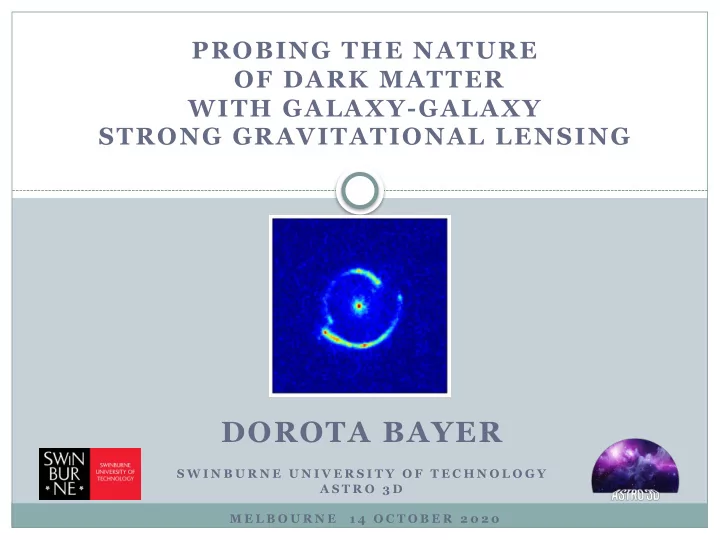

PROBING THE NATURE OF DARK MATTER WITH GALAXY-GALAXY STRONG GRAVITATIONAL LENSING DOROTA BAYER S W I N B U R N E U N I V E R S I T Y O F T E C H N O L O G Y A S T R O 3 D M E L B O U R N E 1 4 O C T O B E R 2 0 2 0
INTRODUCTION
What is the nature of dark matter? phenomenological models MACHOs, particle dark matter based on free-streaming length or modified gravity? HOT ? WARM ? COLD ? Image credits: Bertone & Tait (2018), Ben Moore (University of Zurich)
Sub-galactic mass structure as a probe of DM HOW CLUMPY/SMOOTH IS THE MASS DISTRIBUTION IN GALACTIC HALOES ? Image credit: Lovell et al. (2014)
Sub-halo mass function Image credit: Hsueh et al. (2020)
Sub-halo mass function LOWER LIMIT 5.3 keV Image credit: Hsueh et al. (2020)
Galaxy-galaxy strong gravitational lensing Image credit: ALMA (ESO/NRAO/NAOJ), L. Calçada (ESO), Y. Hezaveh et al.
Substructure lensing Image credit: ALMA (ESO/NRAO/NAOJ), L. Calçada (ESO), Y. Hezaveh et al.
Gravitational imaging of galactic substructure Substructure in Lens Galaxy Perturbations to Smooth Lensing Potential Surface-Brightness Anomalies in Lensed Images Koopmans (2005), Vegetti & Koopmans (2009)
Gravitational imaging of galactic substructure Substructure in Lens Galaxy Perturbations to Smooth Lensing Potential Surface-Brightness Anomalies in Lensed Images Koopmans (2005), Vegetti & Koopmans (2009)
Gravitational imaging of galactic substructure SDSS J120602.09+514229.5 SDSS J0946+1006 sub-halo mass = 2.75 * 10^10 sub-halo mass = 1.9 * 10^8 M ☉ M ☉ redshift = 0.422 redshift = 0.881 Image credits: Vegetti et al. (2010b, 2012)
Sub-halo mass function Image credit: Hsueh et al. (2020)
NOVEL STATISTICAL APPROACH
Our approach Density Fluctuations in the Lens Galaxy Perturbations to Smooth Lensing Potential Surface-Brightness Anomalies in the Lensed Images Chatterjee & Koopmans (2018), Bayer et al. (submitted to MNRAS)
Our approach Density Fluctuations in the Lens Galaxy GRF Perturbations to Smooth Lensing Potential Surface-Brightness Anomalies in the Lensed Images Chatterjee & Koopmans (2018), Bayer et al. (submitted to MNRAS)
Our approach Density Fluctuations in the Lens Galaxy GRF Perturbations to Smooth Lensing Potential Surface-Brightness Anomalies in the Lensed Images POWER SPECTRUM Chatterjee & Koopmans (2018), Bayer et al. (submitted to MNRAS)
Our approach Density Fluctuations in the Lens Galaxy GRF Perturbations to Smooth Lensing Potential Surface-Brightness Anomalies in the Lensed Images POWER SPECTRUM Chatterjee & Koopmans (2018), Bayer et al. (submitted to MNRAS)
Analysis overview Observed surface-brightness anomalies GRF potential perturbations & mock power spectra Statistical comparison Upper-limit constraints on sub-galactic mass structure (1-10 kpc scales)
SURFACE-BRIGHTNESS ANOMALIES
SLACS lenses Image credit: A. Bolton, SLACS team
SLACS lens systems Image credit: A. Bolton, SLACS team
Step 1: Subtraction of lens-galaxy light SDSS J0252+0039 HST/WFC3/F390W MASK LENS-LIGHT MODEL (GALFIT) GALAXY-SUBTRACTED Bayer et al. (submitted to MNRAS)
Step 2: Smooth lens modeling SMOOTH LENS MODEL: POWER-LAW ELLIPTICAL MASS DISTRIBUTION • Einstein radius • center of mass • position angle • axis ratio mass-density slope • • external shear strength & position angle Adaptive, grid-based, Bayesian lens modeling technique by Vegetti & Koopmans (2009)
Step 3: Residuals SMOOTH LENS MODEL: POWER-LAW ELLIPTICAL MASS DISTRIBUTION • Einstein radius • center of mass • position angle • axis ratio mass-density slope • • external shear strength & position angle Adaptive, grid-based, Bayesian lens modeling technique by Vegetti & Koopmans (2009)
Step 4: Residual power spectrum SMOOTH LENS MODEL: POWER-LAW ELLIPTICAL MASS DISTRIBUTION • Einstein radius • center of mass • position angle • axis ratio mass-density slope • • external shear strength & position angle Adaptive, grid-based, Bayesian lens modeling technique by Vegetti & Koopmans (2009)
Step 4: Surface-brightness anomalies RESIDUALS ANOMALIES NOISE 5 KPC 0.5 KPC Adaptive, grid-based, Bayesian lens modeling technique by Vegetti & Koopmans (2009)
UNDERLYING MASS STRUCTURE
GRF potential perturbations Bayer et al. (submitted to MNRAS)
Best-fitting smooth lens model Image credit: ALMA (ESO/NRAO/NAOJ), L. Calçada (ESO), Y. Hezaveh et al.
Effect of GRF potential perturbations Image credit: ALMA (ESO/NRAO/NAOJ), L. Calçada (ESO), Y. Hezaveh et al.
Mock perturbed lens systems Bayer et al. (submitted to MNRAS)
Template of mock power spectra Bayer et al. (submitted to MNRAS)
Template of mock power spectra LENS POTENTIAL PERTURBATIONS Bayer et al. (submitted to MNRAS)
Template of mock power spectra LENS POTENTIAL PERTURBATIONS SB ANOMALIES IN LENSED IMAGES Bayer et al. (submitted to MNRAS)
Comparison with data LENS POTENTIAL PERTURBATIONS SB ANOMALIES IN LENSED IMAGES Bayer et al. (submitted to MNRAS)
Exclusion probability Bayer et al. (submitted to MNRAS)
DOUBLE RING LENS SYSTEM
Constraints from the Double Ring system SDSS J0946+1006 HST/ACS/814W excluded Bayer et al. (in prep)
Constraints from the Double Ring system EXCLUDED Bayer et al. (in prep)
Constraints from the Double Ring system EXCLUDED Bayer et al. (in prep)
Constraints from the Double Ring system EXCLUDED Bayer et al. (in prep)
Constraints from the Double Ring system EXCLUDED Bayer et al. (in prep)
Constraints from the Double Ring system UPPER LIMIT Bayer et al. (in prep)
Constraints from the Double Ring system ALLOWED Bayer et al. (in prep)
Collaborators Leon Koopmans Saikat Chatterjee Simona Vegetti John McKean Chris Fassnacht Tomasso Treu
Summary & Future work Summary Novel approach to modelling small-scale structure in galactic haloes Gaussian random fields density fluctuations Power spectrum of surface-brightness anomalies First constraints on sub-galactic mass power spectrum (1-10 kpc) Future work Larger sample Machine-learning approach Comparison to hydrodynamical simulations - alternative dark matter models - various galaxy formation scenarios Bayer et al. (submitted to MNRAS)
Recommend
More recommend